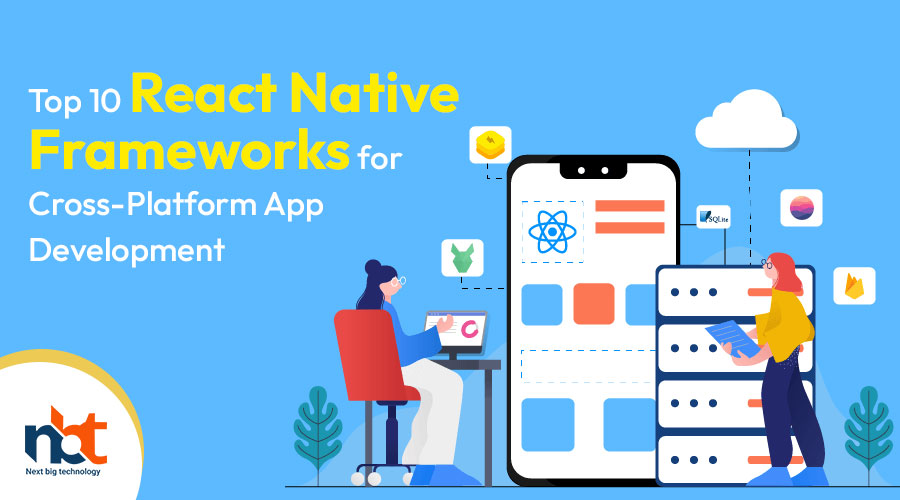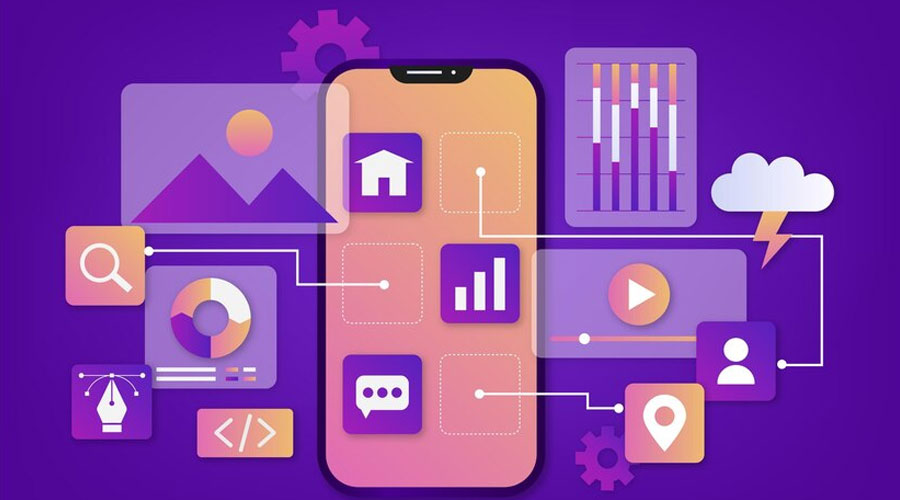Table of Contents
Introduction to React Native Frameworks
In the ever-evolving landscape of mobile app development, React Native has emerged as a game-changer. Its ability to build cross-platform applications with native-like performance using JavaScript has revolutionized the way developers create mobile apps. However, the power of React Native doesn’t end with its core functionality. It’s further enhanced by a multitude of frameworks and libraries that extend its capabilities and streamline the development process. In this article, we’ll delve into the world of React Native frameworks, providing a comprehensive introduction for beginners.
Understanding React Native Frameworks
React Native frameworks are essentially pre-built tools, libraries, and extensions that complement the core React Native functionality. They provide developers with ready-made solutions for common challenges, such as UI design, state management, navigation, and more. These frameworks aim to boost productivity, maintain code quality, and facilitate rapid development.
Popular React Native Frameworks
- Expo: Expo is perhaps the most well-known React Native framework, offering a set of tools and services that simplify the development workflow. It provides a convenient way to start a new React Native project without dealing with complex configuration setups. Expo also includes features like over-the-air updates, push notifications, and access to device APIs, making it ideal for building prototypes and production-ready apps alike.
- React Navigation: Navigation is a critical aspect of mobile app development, and React Navigation is a widely-used library for handling navigation in React Native applications. It offers a flexible and customizable navigation solution with support for various navigation patterns, such as stack, tab, drawer, and more. React Navigation seamlessly integrates with React Native components, providing a smooth user experience across different screens and workflows.
- Redux: State management is another key concern in complex React Native applications, and Redux is a popular library for managing application state in a predictable and efficient manner. Redux facilitates the centralized management of state, making it easier to maintain and debug large-scale applications. With Redux, developers can define actions and reducers to update state in a consistent and predictable way, resulting in more maintainable codebases.
- Styled Components: Styled Components is a library that allows developers to write CSS in JavaScript, enabling them to create reusable and composable styling components for their React Native applications. By encapsulating styles within components, Styled Components promote better organization and encapsulation of styling logic, leading to more maintainable and modular code.
- NativeBase: NativeBase is a UI component library for React Native that offers a wide range of pre-designed UI components, such as buttons, cards, forms, and more. It simplifies the process of building visually appealing and responsive user interfaces by providing a set of customizable and reusable components out of the box. NativeBase components adhere to platform-specific design guidelines, ensuring a consistent look and feel across different devices and platforms.
What is React Native Frameworks?
In the ever-evolving landscape of mobile app development, React Native has emerged as a powerful framework, enabling developers to build cross-platform applications with ease. However, within the realm of React Native, various frameworks and libraries have been developed to streamline the development process further and enhance the capabilities of applications. In this article, we delve into the realm of React Native frameworks, exploring their significance and functionality.
What are React Native Frameworks?
React Native frameworks are collections of pre-built components, libraries, and tools designed to expedite the development of mobile applications using the React Native framework. These frameworks aim to address common challenges faced by developers, such as UI design, state management, navigation, and integration with native modules.
Significance of React Native Frameworks
- Accelerated Development: React Native frameworks provide ready-to-use components and functionalities, reducing development time and effort significantly.
- Consistent UI/UX: Frameworks offer standardized UI components and design patterns, ensuring consistency across different platforms and devices.
- Improved Performance: Many frameworks optimize performance by implementing best practices and utilizing native modules efficiently.
- Simplified Maintenance: By leveraging frameworks, developers can maintain codebases more effectively, facilitating updates and bug fixes.
Popular React Native Frameworks
- Expo: Expo is a comprehensive toolkit for building native apps with React Native. It provides a set of universal APIs and development tools, allowing developers to create, deploy, and manage React Native applications effortlessly. Expo simplifies tasks like app configuration, OTA updates, and push notifications.
- React Navigation: React Navigation is a routing and navigation library for React Native applications. It offers a flexible and customizable navigation solution, supporting various navigation patterns such as stack, tab, and drawer navigation. React Navigation streamlines the implementation of navigation logic, enabling smooth transitions between screens.
- Redux: Redux is a predictable state container for JavaScript applications, including React Native. It provides a centralized store for application state management, making it easier to manage and manipulate data throughout the app. Redux facilitates scalable and maintainable app architectures, particularly in complex applications with extensive data flow.
- NativeBase: NativeBase is a UI component library for React Native applications. It offers a rich collection of cross-platform UI components, ranging from basic elements like buttons and inputs to complex components like lists and cards. NativeBase simplifies UI development by providing pre-styled and customizable components, ensuring a polished and responsive user interface.
- Firebase: Firebase is a mobile and web application development platform that provides a plethora of services, including authentication, real-time database, cloud storage, and analytics. With Firebase, developers can integrate powerful backend functionalities into React Native applications seamlessly. Firebase’s SDKs and APIs abstract complex backend operations, enabling rapid development and deployment of feature-rich apps.
How to Create a React Native Frameworks for Cross-Platform App Development?
In today’s fast-paced digital landscape, cross-platform app development has become a necessity for businesses looking to reach a wider audience. With the emergence of frameworks like React Native, developers now have powerful tools at their disposal to streamline the development process and deliver high-quality apps across multiple platforms efficiently. If you’re eager to harness the potential of React Native and create your own frameworks for cross-platform app development, you’ve come to the right place. In this guide, we’ll walk you through the essential steps to kickstart your journey towards building robust and scalable React Native frameworks.
Understanding React Native: Before diving into framework creation, it’s crucial to grasp the fundamentals of React Native. Developed by Facebook, React Native is an open-source framework that enables developers to build mobile applications using JavaScript and React. What sets React Native apart is its ability to render native components, resulting in app performance that closely resembles that of native apps.
Identifying Requirements: The first step in creating a React Native framework is to identify the specific requirements of your project. Consider factors such as target platforms, desired features, and performance benchmarks. By clearly defining your objectives, you can streamline the development process and ensure that your framework meets the needs of your target audience.
Architectural Design: Next, focus on designing the architecture of your React Native framework. Determine the core components, modules, and functionalities that will form the backbone of your framework. Pay attention to factors such as modularity, scalability, and maintainability to ensure that your framework can accommodate future updates and enhancements seamlessly.
Implementing Core Features: With the architectural design in place, it’s time to start implementing the core features of your React Native framework. Leverage the power of React Native’s component-based architecture to create reusable UI elements, navigation systems, and data management solutions. Aim for simplicity and consistency to facilitate a smooth development experience for your users.
Testing and Debugging: Once you’ve developed the initial version of your React Native framework, thorough testing and debugging are essential to identify and resolve any issues or bugs. Utilize tools like Jest and React Native Debugger to conduct comprehensive testing across different devices and platforms. Solicit feedback from beta testers and iterate on your framework based on their input to ensure optimal performance and reliability.
Documentation and Support: Finally, don’t overlook the importance of documentation and support for your React Native framework. Provide comprehensive documentation that outlines installation instructions, usage guidelines, and troubleshooting tips. Establish channels for community support, such as forums or Slack channels, where developers can seek assistance and share their experiences.
What is React Native & How Does It Help Developers Create Cross-Platform Apps?
In today’s fast-paced digital world, mobile applications have become an integral part of our lives. With the rise in demand for mobile apps across different platforms, developers are constantly seeking efficient ways to build high-quality applications while minimizing time and resources. This is where React Native emerges as a game-changer.
What is React Native?
React Native is an open-source framework developed by Facebook that enables developers to build mobile applications using JavaScript and React. Unlike traditional methods that require separate codebases for iOS and Android platforms, React Native allows developers to write code once and deploy it across multiple platforms, making it a powerful tool for cross-platform app development.
How Does React Native Help Developers Create Cross-Platform Apps?
- Code Reusability: One of the key advantages of React Native is code reusability. Developers can write code once and reuse it across different platforms, saving time and effort in the development process. This significantly reduces the need for maintaining separate codebases for iOS and Android, leading to faster development cycles and lower costs.
- Native Performance: Despite using JavaScript, React Native provides native-like performance by leveraging native components. It allows developers to build applications with smooth animations, fast load times, and responsive interfaces, ensuring a seamless user experience across platforms.
- Hot Reloading: React Native comes with a built-in feature called hot reloading, which allows developers to see the changes they make in real-time without recompiling the entire application. This not only speeds up the development process but also improves productivity by providing instant feedback on code changes.
- Access to Native APIs: React Native provides access to native APIs, allowing developers to integrate device-specific features seamlessly into their applications. Whether it’s accessing the camera, GPS, or push notifications, React Native makes it easy to leverage the full capabilities of the underlying platform.
- Large Community and Ecosystem: With a large and active community of developers, React Native has a vast ecosystem of libraries, tools, and resources to support app development. Developers can easily find solutions to common problems, share knowledge, and collaborate with others in the community, making the development process smoother and more efficient.
- Cost-Effectiveness: By enabling code reusability and streamlining the development process, React Native helps companies save time and resources. With faster development cycles and lower maintenance costs, businesses can bring their apps to market faster and stay competitive in today’s rapidly evolving landscape.
Advanced Features of React Native Frameworks for Cross-Platform App Development
In today’s dynamic digital landscape, building robust and user-friendly mobile applications that cater to multiple platforms has become a necessity for businesses aiming to establish a strong online presence. React Native, a popular open-source framework developed by Facebook, has emerged as a game-changer in the realm of cross-platform app development. Its advanced features offer developers a powerful toolkit to create high-performance applications efficiently. Let’s delve into some of these advanced features and understand how they facilitate seamless cross-platform development.
- Hot Reloading: React Native’s Hot Reloading feature allows developers to instantly see the changes they make in the code reflected on the application screen. This significantly accelerates the development process as developers can quickly iterate on the design and functionality without the need for time-consuming recompilation.
- Native Module Support: React Native enables developers to incorporate native modules written in languages like Java, Objective-C, or Swift into their applications. This feature grants access to device-specific functionalities, such as GPS, camera, or accelerometer, ensuring a seamless user experience across different platforms.
- Reusable Components: One of the key advantages of React Native is its component-based architecture. Developers can create reusable UI components that can be shared across multiple platforms, thereby reducing development time and effort. This modular approach not only streamlines the development process but also enhances code maintainability and scalability.
- Third-Party Plugin Integration: React Native boasts a vast ecosystem of third-party plugins and libraries, offering developers access to a plethora of pre-built components and functionalities. Whether it’s integrating payment gateways, social media APIs, or analytics tools, developers can leverage these plugins to extend the capabilities of their applications effortlessly.
- Optimized Performance: React Native employs a virtual DOM (Document Object Model) to efficiently manage UI updates, resulting in smoother rendering and improved performance. Furthermore, React Native’s asynchronous JavaScript interactions and native code optimization techniques contribute to faster app loading times and enhanced responsiveness.
- Code Push: With React Native’s Code Push feature, developers can push updates directly to users’ devices without going through the app store approval process. This enables businesses to deliver critical bug fixes, feature enhancements, and security patches swiftly, ensuring a seamless user experience and minimizing downtime.
- Cross-Platform Compatibility: React Native allows developers to write code once and deploy it across multiple platforms, including iOS, Android, and even web applications. This cross-platform compatibility not only saves development time and resources but also ensures consistency in the user experience across different devices and operating systems.
- Community Support and Documentation: React Native boasts a vibrant community of developers who actively contribute to its growth and improvement. With extensive documentation, tutorials, and online forums, developers can easily find solutions to their queries and stay updated with the latest developments in the React Native ecosystem.
How Much Does It Cost to Build a React Native Frameworks for Cross-Platform App Development?
In today’s digital era, businesses are constantly seeking efficient ways to expand their reach and engage with a broader audience. With the rise of mobile applications, cross-platform app development has emerged as a popular choice for companies looking to develop apps that work seamlessly across multiple platforms. React Native, a JavaScript framework developed by Facebook, has gained significant traction in this space due to its ability to build high-quality, native-like apps for both iOS and Android platforms.
However, before diving into the development process, it’s essential to understand the costs associated with building React Native frameworks for cross-platform app development. Let’s explore the various factors that contribute to the overall cost:
- App Complexity: The complexity of the app plays a significant role in determining development costs. Simple apps with basic functionalities will naturally cost less compared to complex applications that require integration with third-party APIs, advanced animations, and intricate features.
- Design Requirements: A well-designed app enhances user experience and attracts more users. The cost of design includes creating wireframes, mockups, and user interface (UI) design. Complex designs with custom animations and interactions may require additional resources, thus increasing the overall cost.
- Development Time: Time is money, and the longer it takes to develop an app, the higher the cost. React Native offers faster development cycles compared to traditional native app development, thanks to its code reusability across platforms. However, factors such as app complexity and integration with backend systems can extend the development timeline and subsequently increase costs.
- Integration with Backend Systems: Many apps require integration with backend servers or databases to fetch data and perform operations. The complexity of backend integration can vary based on factors such as data volume, security requirements, and the need for real-time updates. This integration adds to the overall development cost.
- Testing and Quality Assurance: Thorough testing is essential to ensure the app functions smoothly across different devices and operating systems. Testing involves detecting and fixing bugs, performance optimization, and ensuring compliance with app store guidelines. The cost of testing depends on the scope and complexity of the app.
- Maintenance and Updates: Building an app is just the beginning; maintaining it over time is equally important. This includes fixing bugs, updating features, and ensuring compatibility with the latest operating system versions. Budgeting for ongoing maintenance is crucial to keep the app relevant and competitive in the long run.
- Developer Rates: The cost of hiring developers varies based on their experience, location, and skill level. Experienced developers may demand higher rates but can deliver high-quality results efficiently. Offshore development teams may offer lower rates, but communication barriers and time zone differences could affect project timelines and quality.
Boost Your Cross-Platform App Development
In today’s rapidly evolving digital landscape, having a strong online presence is essential for businesses to thrive. Mobile applications have become a cornerstone of this digital strategy, enabling companies to engage with their customers in innovative and meaningful ways. However, developing mobile apps that run seamlessly across multiple platforms can be a daunting task. Enter cross-platform app development – a game-changer for businesses looking to expand their reach and maximize their impact.
Cross-platform app development refers to the process of building mobile applications that can run on multiple operating systems, such as iOS and Android, using a single codebase. This approach offers numerous advantages over traditional native app development, including cost-effectiveness, faster time to market, and easier maintenance. By leveraging frameworks like React Native, Flutter, or Xamarin, businesses can streamline the app development process and reach a broader audience with minimal effort.
One of the key benefits of cross-platform app development is its ability to reduce development costs significantly. Instead of building separate apps for each platform, developers can write code once and deploy it across multiple platforms, saving both time and resources. This cost-effective approach is particularly beneficial for startups and small businesses with limited budgets, allowing them to compete with larger enterprises on a level playing field.
Moreover, cross-platform app development offers faster time to market, enabling businesses to launch their apps more quickly and capitalize on market opportunities. Since developers can reuse code across platforms, they can accelerate the development process and deliver high-quality apps in record time. This agility is crucial in today’s fast-paced digital economy, where speed and innovation are key drivers of success.
In addition to cost savings and faster time to market, cross-platform app development also simplifies maintenance and updates. Instead of managing multiple codebases for different platforms, developers can make changes to a single codebase and deploy updates simultaneously across all platforms. This streamlined approach not only saves time but also ensures consistency and reliability across the entire app ecosystem.
Furthermore, cross-platform apps offer a consistent user experience across different devices and operating systems, enhancing customer satisfaction and engagement. By delivering a seamless experience regardless of the device or platform, businesses can build brand loyalty and foster long-term relationships with their customers. This consistency is essential in today’s multi-device world, where users expect a cohesive experience across all their devices.
How Does the React Native Frameworks App?
In today’s fast-paced digital landscape, mobile app development has become paramount for businesses aiming to stay competitive and reach a wider audience. Among the various frameworks available, React Native has emerged as a popular choice due to its efficiency and versatility. But how exactly does React Native empower app development? Let’s delve into its key features and functionalities.
Seamless Cross-Platform Development: One of the most significant advantages of React Native is its ability to facilitate cross-platform development. Instead of creating separate codebases for iOS and Android applications, developers can write a single codebase that works across both platforms. This not only saves time and resources but also ensures consistency in the user experience.
Reusable Components: React Native allows developers to build modular and reusable components, which can be easily incorporated into different parts of the application. These components encapsulate specific functionalities, making the codebase more organized and maintainable. Additionally, React Native’s component-based architecture promotes code reusability, reducing redundancy and enhancing development efficiency.
Hot Reloading: The hot reloading feature in React Native enables developers to see the changes they make to the code in real-time, without the need to recompile the entire application. This significantly speeds up the development process, allowing developers to iterate quickly and make adjustments on the fly. With hot reloading, developers can instantly preview the effects of their code changes, leading to a more seamless and efficient development experience.
Native Performance: Despite being a JavaScript framework, React Native delivers native-like performance by leveraging platform-specific components and APIs. By rendering UI elements using native controls, React Native ensures that the app feels responsive and performs well across different devices. This approach combines the efficiency of web development with the performance of native applications, offering the best of both worlds to developers.
Strong Community Support: React Native benefits from a vibrant and active community of developers, contributors, and enthusiasts. This community-driven ecosystem provides valuable resources, including libraries, tools, and documentation, to support developers throughout the app development process. Whether seeking advice, troubleshooting issues, or sharing insights, developers can rely on the React Native community for assistance and collaboration.
Continuous Improvement: The React Native framework is continuously evolving, with regular updates and enhancements introduced by Facebook and the open-source community. These updates address bugs, introduce new features, and improve performance, ensuring that React Native remains a cutting-edge solution for mobile app development. By staying abreast of the latest developments, developers can leverage the full potential of React Native and deliver high-quality applications to users.
Top 10 React Native Frameworks for Cross-Platform App Development Companies
In the ever-evolving landscape of mobile app development, React Native has emerged as a game-changer, offering a seamless approach to building cross-platform applications. Leveraging the power of JavaScript, React Native enables developers to craft robust and high-performance apps for both iOS and Android platforms, simultaneously reducing development time and costs. To further streamline the development process, developers often rely on various frameworks that enhance productivity and extend the capabilities of React Native. Here, we unveil the top 10 React Native frameworks that are empowering cross-platform app development companies worldwide.
-
Next Big Technology:

Focus Area
- Mobile App Development
- App Designing (UI/UX)
- Software Development
- Web Development
- AR & VR Development
- Big Data & BI
- Cloud Computing Services
- DevOps
- E-commerce Development
Industries Focus
- Art, Entertainment & Music
- Business Services
- Consumer Products
- Designing
- Education
- Financial & Payments
- Gaming
- Government
- Healthcare & Medical
- Hospitality
- Information Technology
- Legal & Compliance
- Manufacturing
- Media
- NativeBase: As a UI component library for React Native, NativeBase offers a plethora of customizable components that adhere to platform-specific design guidelines. By streamlining UI development, NativeBase enables developers to create visually stunning apps with minimal effort, enhancing both efficiency and aesthetics.
- React Navigation: Navigation is a crucial aspect of mobile app development, and React Navigation simplifies routing and navigation in React Native applications. With support for various navigation patterns, including stack, tab, and drawer navigation, React Navigation ensures a smooth and intuitive user experience across different platforms.
- Redux: Redux is a state management library that facilitates predictable state management in React Native applications. By centralizing application state and enabling seamless data flow, Redux simplifies complex app logic and enhances maintainability, making it an indispensable tool for large-scale projects.
- React Native Elements: React Native Elements provides a comprehensive collection of cross-platform UI components that adhere to the Material Design guidelines. From buttons and icons to cards and sliders, React Native Elements empowers developers to create consistent and visually appealing interfaces with ease.
- React Native Firebase: Firebase offers a suite of backend services that seamlessly integrate with React Native applications. From authentication and real-time database to cloud messaging and analytics, React Native Firebase simplifies backend development, allowing developers to focus on building innovative features.
- MobX: Similar to Redux, MobX is a state management library that facilitates reactive programming in React Native applications. With its simple and intuitive API, MobX enables developers to achieve fine-grained control over application state, resulting in faster rendering and improved performance.
- React Native Paper: Developed by the team behind Material Design, React Native Paper provides a set of customizable components that adhere to the Material Design guidelines. By promoting design consistency and adherence to platform conventions, React Native Paper enhances the overall user experience of React Native apps.
- React Native Debugger: Debugging is an essential aspect of the development process, and React Native Debugger simplifies the task by providing a dedicated debugging tool for React Native applications. With features like real-time code inspection and Redux DevTools integration, React Native Debugger streamlines the debugging workflow, enabling developers to identify and fix issues quickly.
- React Native Testing Library: Testing is crucial for ensuring the reliability and quality of React Native applications, and the React Native Testing Library provides a set of utilities for testing React Native components. By promoting a user-centric testing approach, React Native Testing Library facilitates the creation of robust and maintainable test suites, empowering developers to deliver high-quality apps with confidence.
FAQs on 10 React Native Frameworks for Cross-Platform App Development
In the dynamic world of app development, React Native has emerged as a powerful tool for crafting cross-platform applications. Leveraging its flexibility and efficiency, developers often explore various frameworks built around React Native to streamline their development process further. To address the curiosity and concerns of developers, here’s a comprehensive FAQ guide on 10 React Native frameworks for cross-platform app development.
- What are React Native frameworks? React Native frameworks are pre-built libraries or sets of tools designed to enhance the development experience with React Native. These frameworks offer additional functionalities, components, or utilities to expedite the app development process.
- Why use React Native frameworks? React Native frameworks provide ready-made solutions to common development challenges, saving developers time and effort. They offer a range of features such as UI components, navigation systems, state management, and more, helping developers build robust and feature-rich applications efficiently.
- Which are the top React Native frameworks available? Some of the top React Native frameworks include:
- Expo
- React Native Elements
- NativeBase
- React Native Paper
- Shoutem
- Ignite CLI
- React Native Navigation
- React Native Material UI
- React Native Firebase
- MobX
- How do these frameworks differ from one another? Each React Native framework has its unique set of features and focuses. For instance, Expo is renowned for its ease of use and comprehensive tooling, while Ignite CLI offers a powerful development environment with built-in generators and boilerplates. Understanding the specific features and focus of each framework can help developers choose the most suitable one for their project.
- Are these frameworks compatible with all platforms? Most React Native frameworks are designed to facilitate cross-platform development, meaning they support both iOS and Android platforms. However, developers should verify compatibility with their target platforms before integrating a framework into their project.
- Are these frameworks open source? Yes, the majority of React Native frameworks are open source, allowing developers to access and contribute to their development freely. This open-source nature fosters community collaboration and innovation within the React Native ecosystem.
- How can I get started with these frameworks? Getting started with React Native frameworks typically involves installing the framework’s dependencies, integrating it into your project, and exploring its documentation and examples. Most frameworks provide detailed guides and tutorials to help developers kickstart their development journey.
- Are these frameworks suitable for large-scale projects? Yes, many React Native frameworks are well-suited for large-scale projects, offering scalability, performance optimization, and robust architecture. However, developers should conduct thorough testing and optimization to ensure compatibility and stability at scale.
- Can I customize these frameworks to fit my project requirements? Absolutely! React Native frameworks often provide extensive customization options, allowing developers to tailor the framework to their specific project needs. Whether it’s customizing UI components, integrating third-party libraries, or extending functionality, developers have the flexibility to adapt the framework to suit their requirements.
- Are there any performance considerations when using these frameworks? While React Native frameworks aim to optimize performance, developers should be mindful of potential performance implications, especially when integrating numerous third-party components or libraries. Conducting performance testing and optimization throughout the development process can help mitigate any performance-related issues.
Thanks for reading our post “Top 10 React Native Frameworks for Cross-Platform App Development”. Please connect with us to learn more about Top 10 React Native Frameworks.





















